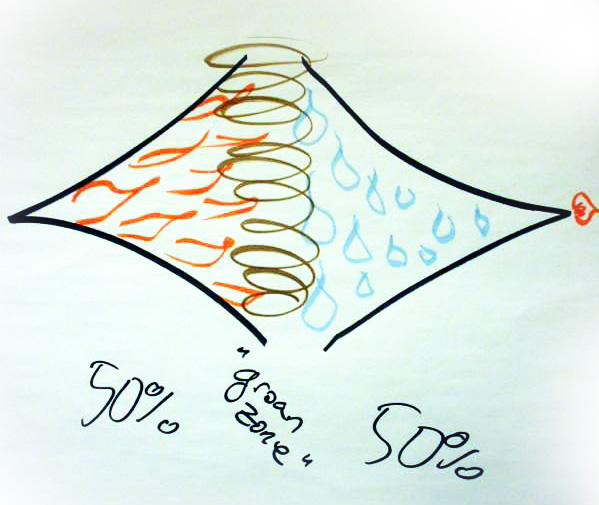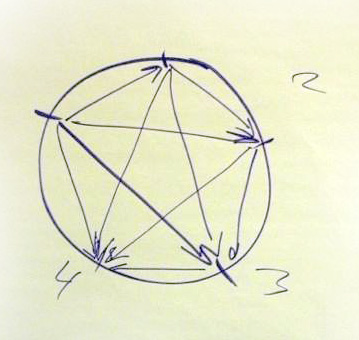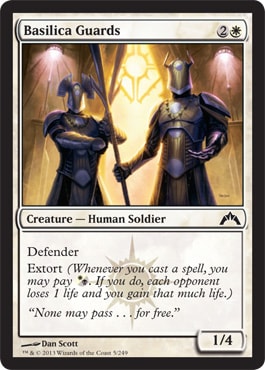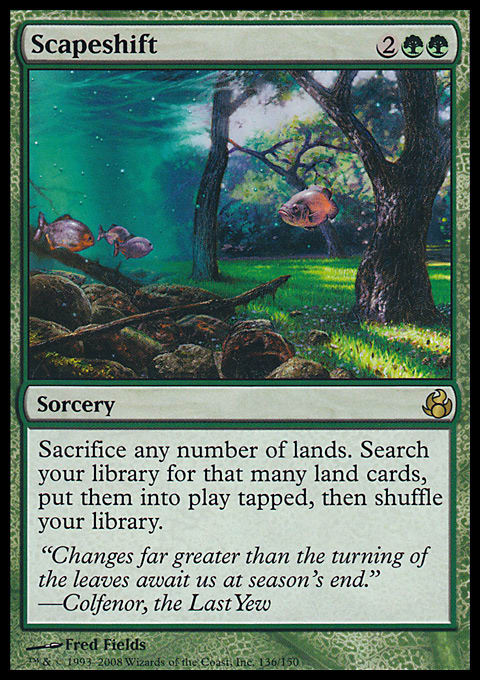I’ve recently done some workshops and sessions on idea generation and facilitating, so in this article, I will present some methods and tools that can help you when you are building decks. Many people have written articles on how to perfect mana bases and how to build the optimal curve. I won’t be doing anything as specific, but I’ll instead present more general ideas that are applicable outside of Magic as well.
From Idea to Action
The process of idea-to-implementation starts with the basic task of generating ideas. The following picture, courtesy of Miikka Penttinen from Grape People, shows how the process goes.

What this shows is that roughly half of the time should be spent on generating ideas and half the time spent on evaluating and processing these ideas. The red flames symbolize the number of ideas increasing as you spend time generating them. The blue water droplets symbolize the dousing you have to do when you cut down a huge number of ideas to just a few viable ones.
What this means for Magic is that you start generating ideas and turning these ideas into actual decks. When you hit the “groan zone,” you might run into problems if you are working with other people. If you have a bunch of ideas within your testing group, you might not all agree on which are the good ones and which are the bad ones. However, to reach the end of the process, you need to get over this and somehow try to collectively decide on which decks you would like to continue with. Often, the reality is that when you are preparing for an event, you have a limited time to try your ideas, and it’s impossible to try them all. This means knowing how to cut down ideas and how to find the good ones is very important.
Idea Generation
So, how do you actually start? There are many techniques that have been developed that you can use when generating ideas, such as brainstorming, listing, using forced associations, brain-writing, and using six thinking hats.
One approach that I think is useful in the context of Magic is what can be called mind emptying. This technique relates to Edward de Bono’s thoughts on human thinking, specifically his thoughts on what he calls lateral thinking.1 When we are trying to come up with new ideas, we can see our thinking as comprised of three layers. The first layer is memory; these are ideas we generate based on previous experiences throughout our life. The second layer is logic; these ideas are formed by reasoning and rationalizing the data available. The last layer is creativity; here, we have the opportunity to come up with something new and really innovative. The human brain often works in such a way that it is impossible to access ideas from the deeper layers without first emptying the ideas that come from our memory. What this means is that you should often spend some time writing down the things that seem obvious. This helps clear your mind, allowing you to more effectively think about totally new ideas.
When it comes to Magic, this might mean that we have some ideas at the tops of our minds based on previous formats or archetypes that are traditionally always present. Such archetypes might include mono-red or white weenie. We are used to these being present in most Constructed formats in the history of Magic, so while looking through a new set, our thoughts often first go to these strategies. The next step might be to look to logic for some ideas. We might have understood that mono-red is a good deck, so we look to logic for ways of combating this. I see control decks as ideas formed through logic and reasoning. They often consist of answers, so you have to think through the possible threats before you look to the answers.
The last step, creativity, is where some very wild ideas start to form. Naturally, many of these ideas are very bad, but at this stage, we are not concerned with eliminating ideas, just generating them. Combo decks are typically ones that might be conceived at this stage, as they often combine cards that do not do much by themselves, but work well together with some other cards. As an example from Gatecrash, we might start brewing up something like with Master Biomancer and Assemble the Legion at this point, as the idea is quite odd in Magic terms (combining four colors and such). Perhaps the best example of a very odd idea that I can remember is the Scapeshift aggro deck from a while back. The deck was primarily an aggro deck with Steppe Lynx and Plated Geopede, but then, it added Scapeshift as a sort of super-landfall card combined with Flagstones of Trokair. This was very unusual because it combined aggro with combo—something not often seen. Combining control with combo has been much more common, as a two-card combo might be the perfect win condition for an otherwise controlling deck.
These principles of different layers of thinking apply equally well to other ways of idea generation, such as brainstorming. It’s mainly a good thing to know, as it is often important to record those memory-based ideas noted down via some method.
Idea Evaluation
Once you have some ideas, it is time to start evaluating them and eliminating some of the bad ones. As with idea generation, there are many methods developed for idea evaluation and selection. Some of the main types of methods are grouping, prioritizing, and analysis.
Grouping is simply the process of clustering similar ideas together. Say you have fifty new deck ideas generated within your playgroup. Many of these are bound to be similar, so you can start by grouping those six separate mono-red decks into the same idea. I think this is best understood if you visualize each deck as a physical object—for example, a Post-It on the wall. When grouping, you simply move these Post-Its to the same cluster on the wall. By grouping ideas together, we already eliminate many of the duplicates present and have an easier time proceeding with the selection process.
Prioritizing is the process of differentiating the ideas—for example, by voting or by selecting with certain criteria. One method for selecting by criteria is giving each person a certain amount to invest in these decks, such as $10. You can then place these dollars on the ideas in any combination you like, so you can give all of it to one idea or spread them out among many ideas.

It’s often tough to decide which the best idea is if you have a group of ideas, and in these cases, I think the value-clock method is good. I apologize in advance if this is not the correct term, as I’ve only used the Finnish word, and “value clock” is a direct translation. You place the different ideas on the face of a clock and then start comparing the ideas to each other. Then, you compare A and B within the group based on some criteria, and if A is better than B, you draw an arrow from B to A. You continue with this until you have compared every idea pair. After this, you can count the number of arrows heading in the direction of a single idea, and the idea with most arrows is the winner. This helps you lower the abstraction level, as it can be tough to compare a group, but comparing a pair is much easier.
Analysis can consist of traditional analysis tools such as SWOT or POINT. You can use these to methodically go through different ideas and identify central traits. POINT is similar to SWOT, and it stands for Plusses, Opportunities, Inquire, and New Thinking. It’s more positive by definition than SWOT, as you think of weaknesses and threats from another perspective.
Idea Implementation
When the idea-selection process is complete, it’s time to start working on them. There are many methods for making ideas into something concrete, but I won’t cover these here, as this article mainly focuses on generating ideas. A whole lot of work goes into perfecting Magic decks after you have come up with the idea, and this is naturally important, too. I’ve written a bit about tuning decks previously, and if there is interest in it, I might write some more about the subject.
Au Revoir
I hope you liked this more theoretical approach to idea generation, and I hope it will help you on some level when you are trying to make new decks. I realize writing and reading about this type of subject can be tough, so if there is something I have written in an unclear manner, be sure to ask if you want clarification.
In just a few days, I’m going to Grand Prix: London, and from there, I’ll be continuing directly to Montreal for the Pro Tour. I will try to write some more about the Gatecrash Limited format next week, as after this weekend, I will surely have had a chance to play a lot of Sealed and Draft. As always, if you have any questions, comments, or ideas, be sure to get in touch either via Twitter or through the comments section below.
Thanks for reading,
Max
@thebloom_ on Twitter
Maxx on Magic Online
You can find my music on: http://soundcloud.com/bloomlive
1 De Bono 1973. LATERAL THINKING: Creativity Step by Step. Perenial.






























